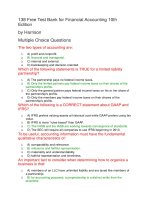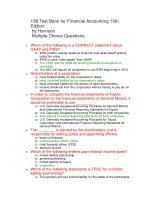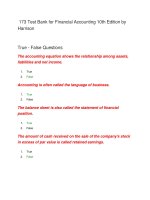Financial accounting 10th pratt peters appendix
Bạn đang xem bản rút gọn của tài liệu. Xem và tải ngay bản đầy đủ của tài liệu tại đây (1.8 MB, 31 trang )
Appendix A:
The Time Value of Money
2
Learning Objective 1
Describe the concept of the time value of money and be able to
compute the future value of a single sum.
3
Time Value of Money
•Future inflows and outflows associated with an asset or liability are predicted and
adjusted in a way that reflects the time value of these inflows and outflows
•The economic value of an asset or liability is its present value – that is the value of
those inflows and outflows adjusted for when they will be received or paid
•You would rather have a dollar now rather than a dollar a year from now because
you can invest it to make it grow
4
Interest: The Price of Money
•Money, like other scarce resources, has a price.
• Interest
•Interest is expressed as a percent over a period of time (usually a year)
•Interest = Principal X Rate X Time
5
Future Value
•The future value is the amount that money will grow to at a certain interest
rate after a certain amount of time.
•Simple Interest
•Compound Interest – Interest earns interest
6
Future Value (cont.)
•Tables have been developed to expedite the calculation process as periods
become much further out.
•The tables are the extension of the formulas.
7
Future Value (cont.)
Figure A-1 Future Value
8
Learning Objective 2
Define an ordinary annuity and an annuity due and be able to compute
their future values.
9
Future Value of Ordinary Annuities
•It often happens that cash payments of equal amounts are made
periodically throughout a period of time.
• A flow of cash payments of equal amounts paid at
•
periodic intervals is
called an annuity.
If these payments are made at the end of each period it is called an ordinary
annuity or annuity in arrears.
10
Figure A-2 Future Value of ordinary annuities
11
Future Value of an Annuity Due
•Annuities paid at the beginning of a period rather than the end are referred
to as an annuity due
• The future value follows the same concept as an ordinary annuity, except that one
more period of interest is calculated because the each payment is made at the
beginning of the period.
12
Figure A-3 Future Value of an annuity due
13
Concept Practice 2
14
Learning Objective 3
Be able to compute the present value of the following cash flows:
single sum, ordinary annuity, and annuity due.
15
Present Value
•What is the present value of a future payment?
•The computation of the present value is exactly the reciprocal of the future
value computation.
•If present value involves more than one period.
16
Present Value (cont.)
•As with future values, tables exist to expedite calculations.
•Present values for ordinary annuities and annuities due are also computed.
17
Figure A-4 Present Value of an ordinary annuity (cont. on next slide)
18
Figure A-4 Present Value of an ordinary annuity (cont.)
19
Figure A-5 Present Value of an annuity due (cont. on next slide)
20
Figure A-5 Present Value of an annuity due (cont.)
21
Equivalent Value
•There are different ways to look at problems; however, present and future value
answers are the same regardless of the methodology used.
•The concept of equivalent value means that an investor is indifferent as to the
receipt of various amounts once the time value of money is applied.
• In the example of the $500 annuity payments in the book, the investor would be
indifferent as to an ordinary annuity of $500 for five years, $1,804 now or $3,176
five years from now.
22
Equivalent Value
Figure A-7 Equivalent values
23
Concept Practice 3
24
Learning Objective 4
Be able to compute an implicit (internal) rate of return.
25









